Abstract
10 normal young men received repository epinephrine repeatedly for 4 days during the course of a radiothyroxine (radio-T4) disappearance curve. During epinephrine administration, serum radio-T4 disappearance rate (k) slowed abruptly, fecal clearance decreased, urinary clearance was initially unchanged but later decreased slightly, volume of thyroxine distribution decreased, and external radioactivity over the liver remained unchanged. Beginning on day 2 of epinephrine and persisting at least 1 day after epinephrine was discontinued, serum thyroxine-binding globulin (TBG) maximal binding capacity increased, thyroxine-binding prealbumin (TBPA) maximal binding capacity decreased, and free T4 iodine decreased. Stable serum T4 iodine decreased during the experiment. Three indexes, namely the free T4 iodine, the reciprocal of TBG capacity, and the urinary radio-T4 “clearance” changed in parallel, suggesting that the increase in TBG capacity was responsible for a delayed decrease in radio-T4 metabolism. However, these changes were temporally dissociated from the decrease in k, which began and ended abruptly with initiation or discontinuing of epinephrine administration. This dissociation is unexplained, but may be caused by alterations in T4 binding in tissue sites.
Full text
PDF
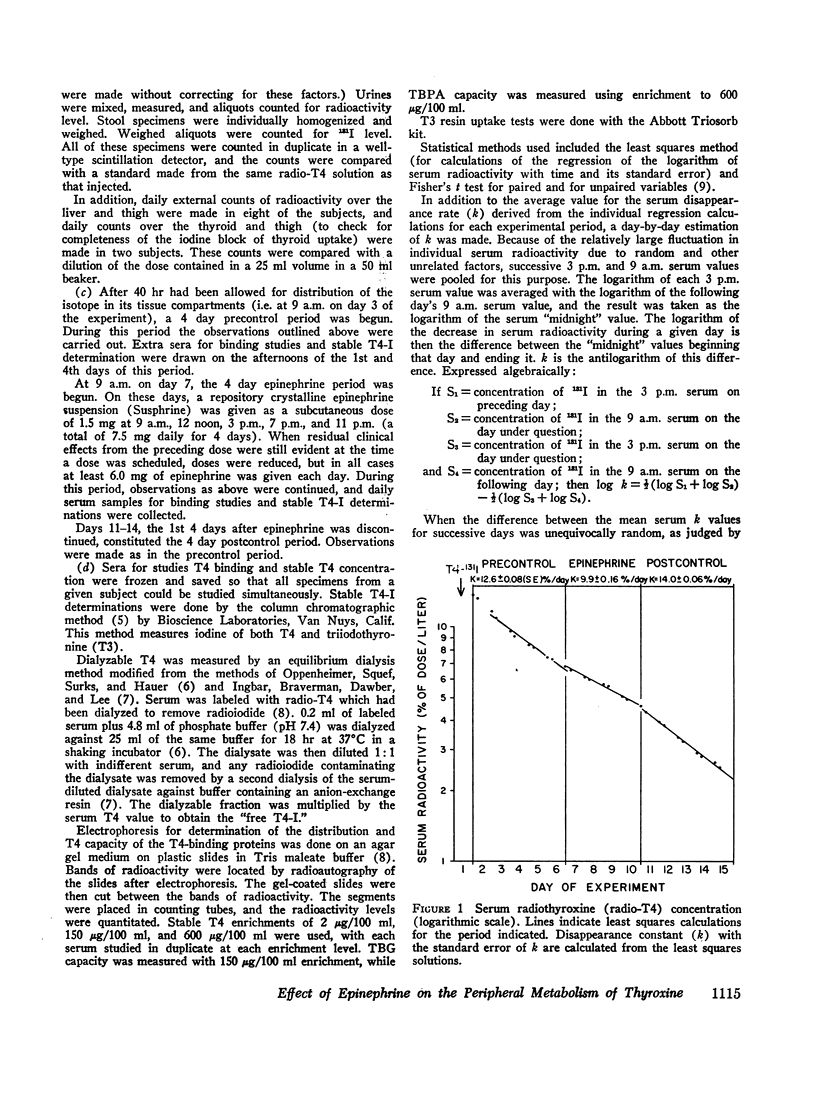
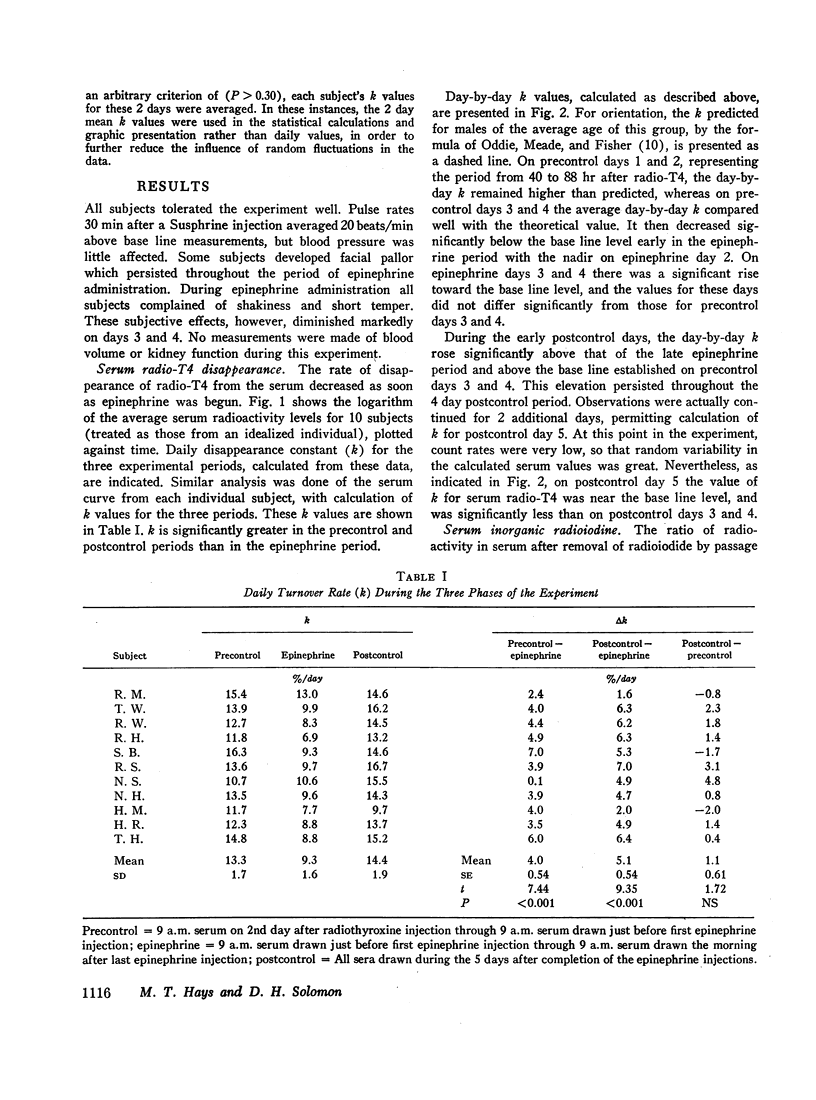
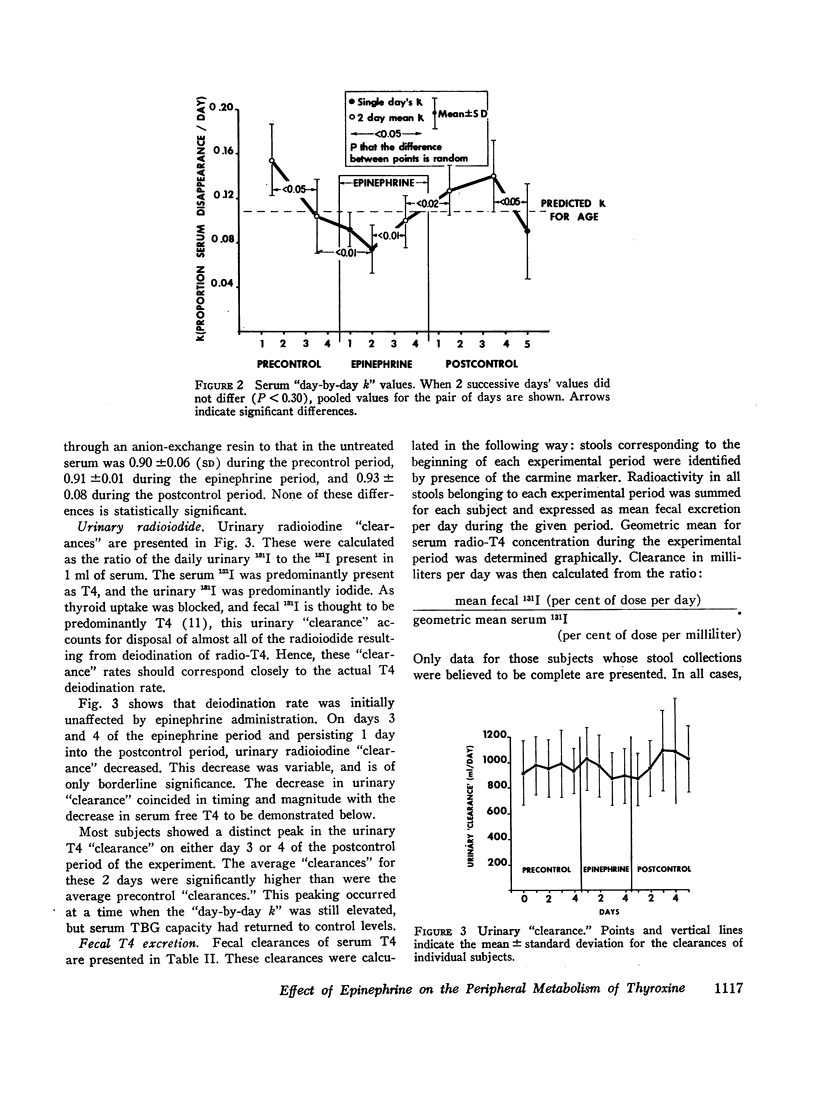
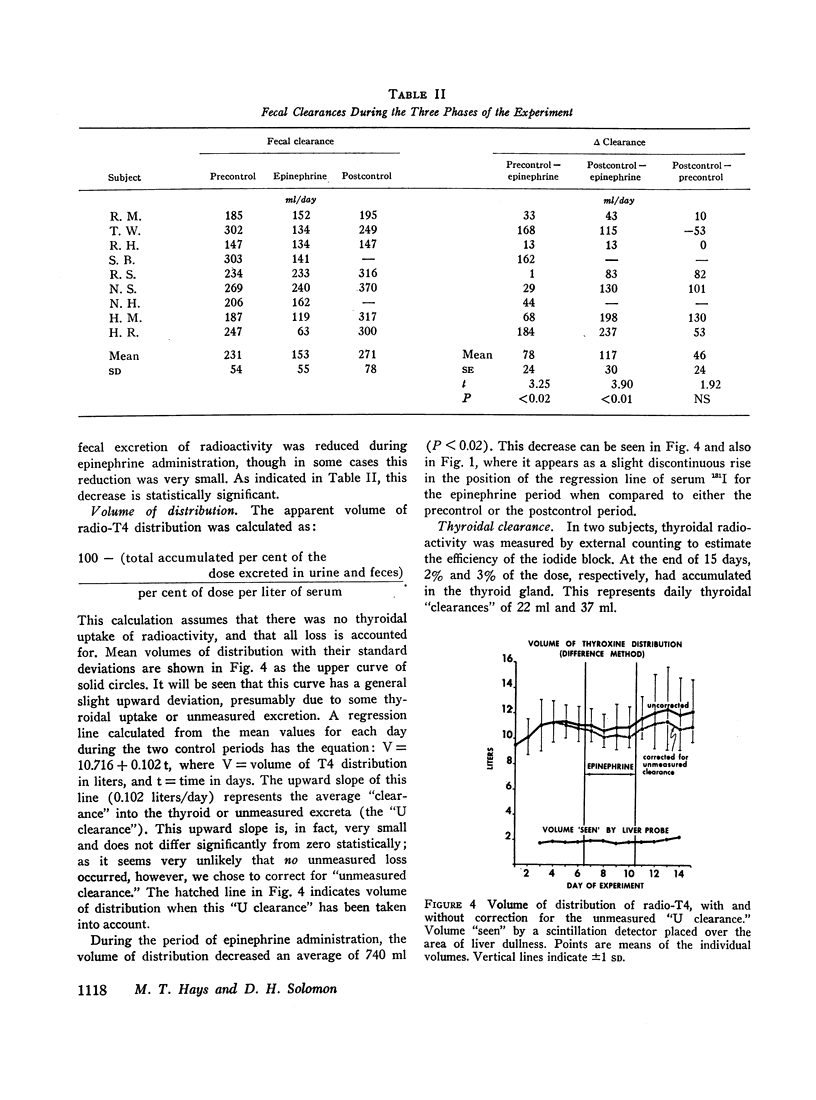

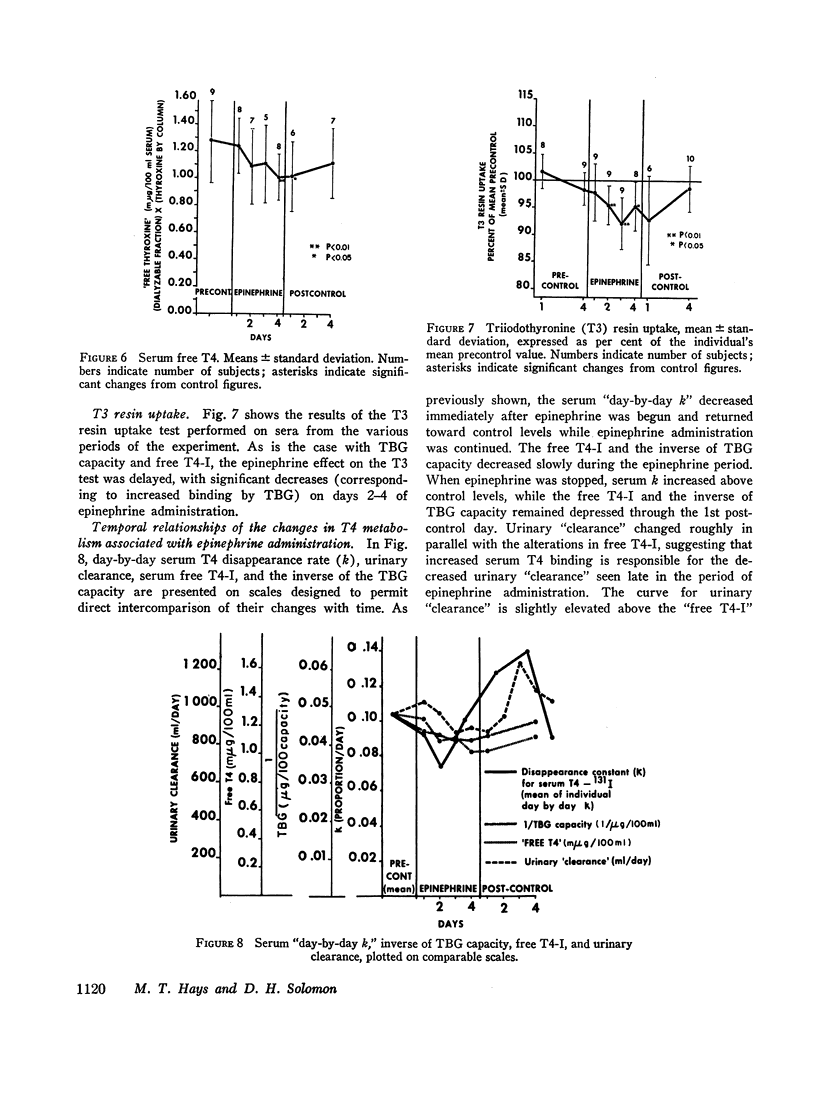


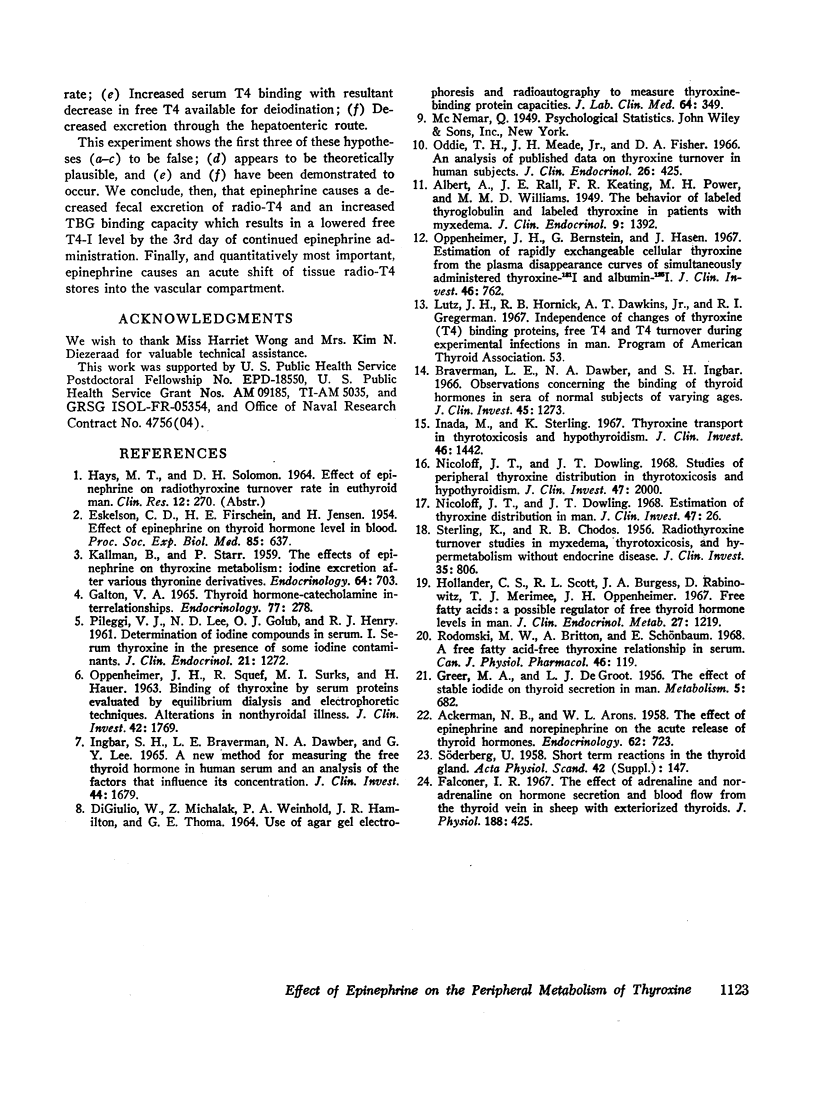
Images in this article
Selected References
These references are in PubMed. This may not be the complete list of references from this article.
- ACKERMAN N. B., ARONS W. L. The effect of epinephrine and norepinephrine on the acute thyroid release of thyroid hormones. Endocrinology. 1958 Jun;62(6):723–737. doi: 10.1210/endo-62-6-723. [DOI] [PubMed] [Google Scholar]
- ALBERT A., RALL J. E. The behavior of labeled thyroglobulin and labeled thyroxine in patients with myxedema. J Clin Endocrinol Metab. 1949 Dec;9(12):1392–1405. doi: 10.1210/jcem-9-12-1392. [DOI] [PubMed] [Google Scholar]
- Braverman L. W., Dawber N. A., Ingbar S. H. Observations concerning the binding of thyroid hormones in sera of normal subjects of varying ages. J Clin Invest. 1966 Aug;45(8):1273–1279. doi: 10.1172/JCI105434. [DOI] [PMC free article] [PubMed] [Google Scholar]
- DEGROOT L. J., GREER M. A. The effect of stable iodide on thyroid secretion in man. Metabolism. 1956 Nov;5(6 Pt 1):682–696. [PubMed] [Google Scholar]
- DIGIULIO W. D., MICHALAK Z., WEINHOLD P. A., HAMILTON J. R., THOMA G. E. USE OF AGAR GEL ELECTROPHORESIS AND AUTORADIOGRAPHY TO MEASURE THYROXINE-BINDING PROTEIN CAPACITIES. J Lab Clin Med. 1964 Aug;64:349–354. [PubMed] [Google Scholar]
- ESKELSON C. D., FIRSCHEIN H. E., JENSEN H. Effect of epinephrine on thyroid hormone level in blood. Proc Soc Exp Biol Med. 1954 Apr;85(4):637–639. doi: 10.3181/00379727-85-20976. [DOI] [PubMed] [Google Scholar]
- Falconer I. R. The effect of adrenaline and noradrenaline on hormone secretion and blood flow from the thyroid vein in sheep with exteriorized thyroids. J Physiol. 1967 Feb;188(3):425–434. doi: 10.1113/jphysiol.1967.sp008147. [DOI] [PMC free article] [PubMed] [Google Scholar]
- Galton V. A. Thyroid hormone-catecholamine interrelationships. Endocrinology. 1965 Aug;77(2):278–284. doi: 10.1210/endo-77-2-278. [DOI] [PubMed] [Google Scholar]
- Hollander C. S., Scott R. L., Burgess J. A., Rabinowitz D., Merimee T. J., Oppenheimer J. H. Free fatty acids: a possible regulator of free thyroid hormone levels in man. J Clin Endocrinol Metab. 1967 Aug;27(8):1219–1223. doi: 10.1210/jcem-27-8-1219. [DOI] [PubMed] [Google Scholar]
- Inada M., Sterling K. Thyroxine transport in thyrotoxicosis and hypothyroidism. J Clin Invest. 1967 Sep;46(9):1442–1450. doi: 10.1172/JCI105636. [DOI] [PMC free article] [PubMed] [Google Scholar]
- Ingbar S. H., Braverman L. E., Dawber N. A., Lee G. Y. A new method for measuring the free thyroid hormone in human serum and an analysis of the factors that influence its concentration. J Clin Invest. 1965 Oct;44(10):1679–1689. doi: 10.1172/JCI105275. [DOI] [PMC free article] [PubMed] [Google Scholar]
- KALLMAN B., STARR P. The effects of epinephrine on thyroxine metabolism: iodine excretion after various thyronine derivatives. Endocrinology. 1959 May;64(5):703–706. doi: 10.1210/endo-64-5-703. [DOI] [PubMed] [Google Scholar]
- Nicoloff J. T., Dowling J. T. Estimation of thyroxine distribution in man. J Clin Invest. 1968 Jan;47(1):26–37. doi: 10.1172/JCI105712. [DOI] [PMC free article] [PubMed] [Google Scholar]
- Nicoloff J. T., Dowling J. T. Studies of peripheral thyroxine distribution in thyrotoxicosis and hypothyroidism. J Clin Invest. 1968 Sep;47(9):2000–2015. doi: 10.1172/JCI105887. [DOI] [PMC free article] [PubMed] [Google Scholar]
- OPPENHEIMER J. H., SQUEF R., SURKS M. I., HAUER H. BINDING OF THYROXINE BY SERUM PROTEINS EVALUATED BY EQUILIBRUM DIALYSIS AND ELECTROPHORETIC TECHNIQUES. ALTERATIONS IN NONTHYROIDAL ILLNESS. J Clin Invest. 1963 Nov;42:1769–1782. doi: 10.1172/JCI104862. [DOI] [PMC free article] [PubMed] [Google Scholar]
- Oddie T. H., Meade J. H., Jr, Fisher D. A. An analysis of published data on thyroxine turnover in human subjects. J Clin Endocrinol Metab. 1966 Apr;26(4):425–436. doi: 10.1210/jcem-26-4-425. [DOI] [PubMed] [Google Scholar]
- Oppenheimer J. H., Bernstein G., Hasen J. Estimation of rapidly exchangeable cellular thyroxine from the plasma disappearance curves of simultaneously administered thyroxine-131-I and albumin-125-I. J Clin Invest. 1967 May;46(5):762–777. doi: 10.1172/JCI105577. [DOI] [PMC free article] [PubMed] [Google Scholar]
- PILEGGI V. J., LEE N. D., GOLUB O. J., HENRY R. J. Determination of iodine compounds in serum. I. Serum thyroxine in the presence of some iodine contaminants. J Clin Endocrinol Metab. 1961 Oct;21:1272–1279. doi: 10.1210/jcem-21-10-1272. [DOI] [PubMed] [Google Scholar]
- Radomski M. W., Britton A., Schönbaum E. A free fatty acid-free thyroxine relationship in serum. Can J Physiol Pharmacol. 1968 Jan;46(1):119–120. doi: 10.1139/y68-019. [DOI] [PubMed] [Google Scholar]
- STERLING K., CHODOS R. B. Radiothyroxine turnover studies in myxedema, thyrotoxicosis, and hypermetabolism without endocrine disease. J Clin Invest. 1956 Jul;35(7):806–813. doi: 10.1172/JCI103333. [DOI] [PMC free article] [PubMed] [Google Scholar]



